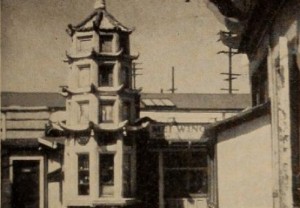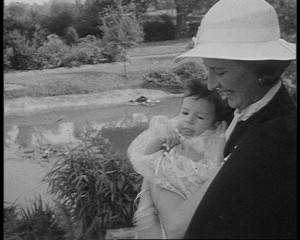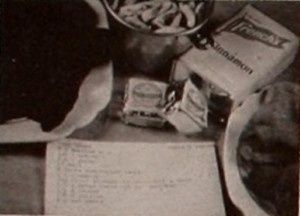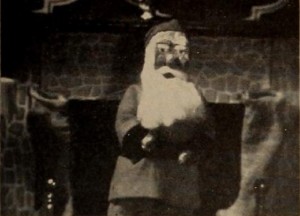
"An idol stolen from a Chinese temple and the efforts of a loyal retainer to recover it provide George Kirstein with a novel springboard for the unfolding of this unusual travel film. Subsequent events carry the principals from New York to Chicago, through the Southwest to Los Angeles and Hollywood, up the coast to San Francisco and finally back to New York for restoration of the idol. Far from hindering the sightseeing sequences, Mr. Kirstein's device enhances the presentation of this material. While the camera handling is satisfying throughout, tighter editing would speed up the pace and heighten dramatic interest." Movie Makers, Dec. 1949, 471.
"This film shows the Kegg family stripping basswood and birch barks and using the bark to make baskets and canoes." Worldcat.org
"The relatively short photoplay, Choosing a Scenario, has been awarded Honorable Mention because it is a smooth and superficially brilliant example of comedy film story making. Originally produced as one of the entries in a group filming contest conducted by the Cinema Club of San Francisco, the picture took first award in that contest for its director, William Palmer. ACL, its cameraman, K. G. Stephens. ACL, and its lone actor, J. Oliver Tucker, ACL. Although comparatively slight in significance, it offers fine photography, intelligent cutting, effective angles and deft acting in telling a clever story with lively tempo." Movie Makers, Dec. 1935, 551.
"Miscellaneous scenes of the sea. Includes brief shots of some boats moored in a foreign harbour and various travelling shots of the sea, taken from on board ship. Concludes with family footage of a young girl walking along a garden path, holding hands with two women and a brief shot of a couple of children playing on a swing" (NWFA Online Database).

"A short film detailing members of the family attending the baptism of Peter Alexander Alliott" (EAFA Database).
"Bringing Kodacolor indoors was the task E. M. Barnard, ACL, set for himself in Christmas 1933, and the result is a 400 foot reel of very charming Christmas studies. One of the few attempts at a complete personal story in color, this picture presents a well photographed and adequately planned film of the youngsters' enjoyment of the holiday. Exposure for interior Kodacolor seems to be no problem to Mr. Barnard, for the majority of his scenes have perfect color rendition as well as very effective and interesting lighting. Some of the studies of his small daughter have an appealing loveliness that is impossible to get in black and white, for they present the very delicate flesh tones with perfect faith as well as the colors of costumes and incidental Christmas background. This film marks a new step in personal indoor filming and leads the way to more extensive use of the color medium by artificial light." Movie Makers, Dec. 1934, 546.
"Among the Ten Best, A Christmas at Home, by Edmund Zacher, II. ACL. is a lovely mine of bright gems which glows with all the warmth and color so surely associated with this festive season. Although essentially of slow pace, the film never once loses appeal, as it presents with loving and tender enthusiasm the countless minutiae of beauty which blend into the charm of Christmas at home. Mr. Zacher's color photography, predominantly interior, is crisp and delicately beautiful, while his sensitive selection of material and cunning choice of angles are an unfailing delight. Multiple exposures of such charm and flawless craftsmanship as almost to defy detection adorn his opening and closing sequences, and the entire production is pleasantly scored with appropriate music and sound effects. More than once a previous winner in these annual selections, Mr. Zacher seems not yet to have reached the full measure of his fine skill with camera and film." Movie Makers, Dec. 1935, 534.

"Christmas at our House reflects the joy that Mrs. Olaf M. Olsen must have experienced in making it. It is an utterly sincere and delightful record of old Norwegian Christmas customs, carried over and observed in the United States by second generation Americans. It presents, in minute detail, the elaborate cookery and decorations of Christmas in Norway. The recipe for each dish and the kitchen utensils required are shown in closeup at the beginning of the individual sequences. Each step in preparing the particular food is then presented in orderly fashion from start to finish. This pattern may sound prosaic, but there is a charm about this film that defies any feeling of monotony. The choice of camera viewpoint and the lighting and exposure in this movie leave nothing to be desired. In fact, the camera handling is so fine that mechanical factors cease to exist, and the spectator feels as if he were actually present within the scene, to watch the action. This movie's titles, done in color, are most attractive, while the editing of the entire picture is smooth and interesting." Movie Makers, Dec. 1941, 541, 563.
"Christmas Nuts, presented with a sound on film recording on a separate 16mm. film, produced by Paul Braun and Howard Goodman, is not only an interior color picture of exceptional beauty and impeccable technical quality but is also one of the best puppet films thus far created. With a camera technique paralleling that of the latest theatrical, animated talkie cartoons, the story of a wolf "hijacking" Santa Claus and the consequent near calamity for the two squirrels is unfolded in a completely cinematic fashion. The camera moves freely from medium shot to closeup, the mechanics of the sets are not obstrusive and the puppets move with agility and grace. The sets, which were designed and constructed with great care, are very handsome and exquisitely finished so that no imperfections are revealed in the enlarged picture of them on the screen. The sets, in combination with the colored lights used in part to illuminate them, embody the producers' theory of "created color." That is, no attempt is made to simulate nature, but rather to produce pleasing, vivid color combinations, as in the illustrations of a child's story book. A cleverly compiled dialog, song and music accompaniment has been synchronized with the picture, although recorded, at present, on a separate film." Movie Makers, Dec. 1935, 534.

"Taking the familiar 'Twas the Night Before Christmas as a theme, Bert Seckendorf and Vic Watson have put together an appealing children's holiday film combining live action with animation. The live action interludes show a father reading the poem to his young son on Christmas Eve, with the familiar lines superimposed at the base of the scene. These connectives then fade out to miniature sets in which animated figures re-enact the well known story of St. Nick. The film suffers from some underexposure and uneven animation in places, but it offers a very pleasant holiday item." Movie Makers, Dec. 1949, 455,468.
Total Pages: 203